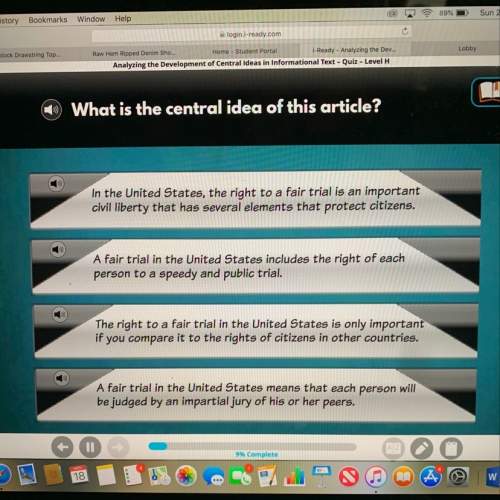
English, 17.06.2021 01:00 meganwintergirl
Successful navigation beneath the surface of the water, though not carried to the extent imagined by Jules Verne, was a reality at the beginning of the twentieth century. Instead of twenty thousand leagues under the sea, less than a hundred leagues had been accomplished, but no one can foretell what the future may have in store.
The submarine is primarily utilized in wars. The weapon used by the submarine is the torpedo. The torpedo is itself a small submarine able to propel itself, and if started in the water toward a certain object, to go under water straight to the mark. It carries a heavy charge, either of guncotton or dynamite, which explodes when the torpedo strikes a solid object, such as a battle-ship.
It would be very difficult for one submarine to fight another submarine, for the submarine when completely submerged is blind. It could not see in the water to find its enemy. The torpedo-boat-destroyer is able to destroy a submarine by torpedoes, shells full of high explosives, or quick-firing guns. Advantage must be taken of the moment when the submarine comes to the surface to get a view of her enemy.
One of the great enemies of the submarine will probably be the air-ship, for while the submarine when under water cannot be seen from a ship on the surface, it can, under favorable conditions, be seen from a certain height in the air.
The rising and sinking of the submarine depend on the principle of Archimedes. The upward push of the water is just equal to the weight of the water displaced. If the water displaced weighs more than the boat, then the upward push of the water is greater than the weight of the boat and the boat rises. However, the boat can be made to dive when its weight is just a little less than the weight of the water displaced. This is done by means of horizontal rudders which may be inclined so as to cause the boat to glide downward as its propeller drives it forward.
There is one submarine built for peaceful pursuits. It is the Argonaut, invented by Simon Lake. This remarkable boat crawls along the bottom of the sea, but not at an immense depth. It is equipped with divers' appliances, and is used in saving wreckage. Divers can go out through the bottom of the boat, walk about on the sea bottom, and when through with their work re-enter the boat; all the while boat and men are, perhaps, a hundred feet below the surface. The divers' compartment, from which the divers go out into the water, is separated by an air-tight partition from the rest of the boat. Compressed air is forced into this compartment until the pressure of the air equals the pressure of the water outside. Then the door in the bottom is opened, and the air keeps the water out. The men in their diving-suits can then go out and in as they please.
For every boat, there is a depth beyond which it must not go. The penalty for going beyond this depth is a battered vessel, for the pressure increases with the depth. Every time the depth is increased thirty-two feet, the pressure is increased fifteen pounds on every square inch. Beyond a certain depth, the vessel cannot resist the pressure. Submarines have been made strong enough to withstand the pressure at a depth of five thousand feet, or nearly a mile. Most submarines, however, cannot go deeper than a hundred and fifty feet.
Air is supplied to the occupants of the boat either from reservoirs containing compressed air or oxygen, or by means of chemicals which absorb the carbon dioxide produced in breathing and restore the needed quantity of oxygen to the air.
Create a summary of the passage by placing the four most important points in the correct order.
Submarines either rise or submerge
by displacing water.
Most submarines are created solely
for military purposes.
Some submarines are used for
oceanic exploration.
All submarines must be sure not to
descend too far underwater.
Certain submarines have a special
chamber for divers.
Sometimes, submarines can be seen
from an airplane.
↓
↓
↓

Answers: 1


Another question on English

English, 21.06.2019 17:00
Read this excerpt from holes. a patrol car pulled alongside him. a policeman asked him why he was running. then he took the shoes and made a call on his radio. shortly thereafter, stanley was arrested. it turned out the sneakers had been stolen from a display at the homeless shelter. that evening rich people were going to come to the shelter and pay a hundred dollars to eat the food that the poor people ate every day for free. clyde livingston, who had once lived at the shelter when he was younger, was going to speak and sign autographs. his shoes would be auctioned, and it was expected that they would sell for over five thousand dollars. all the money would go to the homeless. why does sachar include this description of the shoes in the flashback? a.to show where the shoes came from b.to show how valuable the shoes were c.to reveal why stanley was arrested d.to give background on the homeless shelter
Answers: 1

English, 22.06.2019 00:40
Aids is growing fastest in the poorest countries of africa. these nations don’t have enough doctors, medical labs, or money for medicine. a recent study showed that only a small percentage of hiv-infected children in africa are getting any medical treatment at all. what central idea is emphasized in both sources? the hiv/aids epidemic in africa is serious. the hiv/aids epidemic in south africa is serious. the hiv/aids epidemic among african children is serious. the hiv/aids epidemic among south african children is serious
Answers: 1

English, 22.06.2019 00:50
3. of all the characters highlighted in the works included in this unit, which one did you relate to or identify with the most in terms of his or her struggles and conflicts? why? what was it about this character that made him or her affect you as he or she did? be sure to point to specific examples from the work to support your response.
Answers: 2

English, 22.06.2019 07:30
Which of the following characterizes a true epic and is seen in the r@pe of the lock? a. everyday details c. heroic acts b. humorous contrasts d. impossible events
Answers: 3
You know the right answer?
Successful navigation beneath the surface of the water, though not carried to the extent imagined by...
Questions

Mathematics, 22.06.2019 05:30



Spanish, 22.06.2019 05:30

Mathematics, 22.06.2019 05:30

Mathematics, 22.06.2019 05:30


Chemistry, 22.06.2019 05:40

Physics, 22.06.2019 05:40




Mathematics, 22.06.2019 05:40


Chemistry, 22.06.2019 05:40

Mathematics, 22.06.2019 05:40



Mathematics, 22.06.2019 05:40





